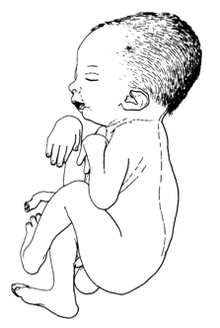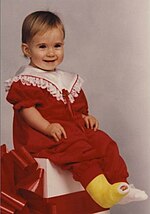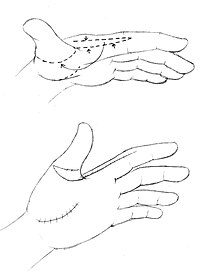Arthrogryposis
| Arthrogryposis | |
|---|---|
| Other names | Arthrogryposis multiplex congenita (AMC) |
 | |
| Drawing of an infant with arthrogryposis | |
| Specialty | Medical genetics |
Arthrogryposis (AMC) describes congenital joint contracture in two or more areas of the body. It derives its name from Greek, literally meaning 'curving of joints' (arthron, 'joint'; grȳpōsis, late Latin form of late Greek grūpōsis, 'hooking').[1]
Children born with one or more joint contractures have abnormal fibrosis of the muscle tissue causing muscle shortening, and therefore are unable to perform active extension and flexion in the affected joint or joints.[2]
AMC has been divided into three groups: amyoplasia, distal arthrogryposis, and syndromic. Amyoplasia is characterized by severe joint contractures and muscle weakness.[3] Distal arthrogryposis mainly involves the hands and feet. Types of arthrogryposis with a primary neurological or muscle disease belong to the syndromic group.[3]
Signs and symptoms
Often, every joint in a patient with arthrogryposis is affected; in 84% all limbs are involved, in 11% only the legs, and in 4% only the arms are involved.[4] Every joint in the body, when affected, displays typical signs and symptoms: for example, the shoulder (internal rotation); wrist (volar and ulnar); hand (fingers in fixed flexion and thumb in palm); hip (flexed, abducted and externally rotated, frequently dislocated); elbow (extension and pronation) and foot clubfoot and less commonly congenital vertical talus.[2][5]
Range of motion can be different between joints because of the different deviations.[6] Some types of arthrogryposis like amyoplasia have a symmetrical joint/limb involvement, with normal sensations.[4][6] The contractures in the joints can result in delayed walking development in the first five years, but severity of contractures do not necessarily predict eventual walking ability or inability.[6]
Intelligence is normal to above normal in children with amyoplasia,[4] but it is not known how many of these children have an above normal intelligence, and there is no literature available about the cause of this syndrome. There are a few syndromes like the Freeman–Sheldon and Gordon syndrome, which have craniofacial involvement.[4] The amyoplasia form of arthrogryposis is sometimes accompanied with a midline facial hemangioma.[4] Arthrogryposis is not a diagnosis but a clinical finding, so this disease is often accompanied with other syndromes or diseases. These other diagnoses could affect any organ in a patient. There are a few slightly more common diagnoses such as
Causes

Research of arthrogryposis has shown that anything that inhibits normal joint movement before birth can result in joint contractures.[3] Arthrogryposis could be caused by genetic and environmental factors. In principle: any factor that curtails fetal movement can result in congenital contractures.[4] The exact causes of arthrogryposis are unknown.
Extrinsic factors
The malformations of arthrogryposis can be secondary to environmental factors such as: decreased
Intrinsic factors
Arthrogryposis could also be caused by intrinsic factors. This includes molecular, muscle- and connective tissue development disorders or neurological abnormalities.[citation needed]
Molecular basis
Research has shown that there are more than 35 specific genetic disorders associated with arthrogryposis. Most of those
Muscle and connective tissue development disorders
Loss of muscle mass with an imbalance of muscle power at the joint can lead to connective tissue abnormality.[2] This leads to joint fixation and reduced fetal movement.[2] Also muscle abnormalities could lead to a reduction of fetal movement. Those could be:
Neurological abnormalities
Seventy to eighty percent of cases of the most severe forms of arthrogryposis are caused by neurological abnormalities, which can be either genetic or environmental.[3]
The underlying aetiology and pathogenesis of congenital contractures, particularly arthrogryposis and the mechanism of the mutations remains an active area of investigation, because identifying these factors could help to develop treatment and congenital finding of arthrogryposis.[3][9]
Diagnosis
Research on prenatal diagnosis has shown that a diagnosis can be made prenatally in approximately 50% of fetuses presenting arthrogryposis.[10] It could be found during routine ultrasound scanning showing a lack of mobility and abnormal position of the foetus.[2] There are other options for visualization of details and structures using techniques such as 4D ultrasound.[2] In clinic a child can be diagnosed with arthrogryposis with physical examination, confirmed by ultrasound, MRI,[3][10] or muscle biopsy.[10]
Classification
Some of the different types of AMC include:
- Arthrogryposis multiplex due to muscular dystrophy.[11][12]
- Arthrogryposis ectodermal dysplasia other anomalies, also known as Cote Adamopoulos Pantelakis syndrome, Trichooculodermovertebral syndrome, TODV syndrome and Alves syndrome.[13][14]
- Arthrogryposis epileptic seizures migrational brain disorder.[15]
- Arthrogryposis IUGR thoracic dystrophy, also known as Van Bervliet syndrome.[16][17]
- Arthrogryposis-like disorder, also known as Kuskokwim disease.[18]
- Arthrogryposis-like hand anomaly and sensorineural deafness.[19][20]
- Arthrogryposis multiplex congenita CNS calcification.[21]
- Arthrogryposis multiplex congenita distal (AMCD), also known as X-linked spinal muscular atrophy type 2.[22][23][24]
- Gordon syndrome, also known as distal arthrogryposis type 3.[25]
- Arthrogryposis multiplex congenita, distal type 2A, also known as Freeman–Sheldon syndrome.[26]
- Arthrogryposis multiplex congenita, distal type 2B, also known as Sheldon–Hall syndrome.[27]
- Arthrogryposis multiplex congenita neurogenic type (AMCN).[28] This particular type of AMC has been linked to the AMCN gene on locus 5q35.[29][30]
- Arthrogryposis multiplex congenita pulmonary hypoplasia, also with a large number of synonyms.[31][32]
- Arthrogryposis multiplex congenita whistling face, also known as Illum syndrome.[33][34][35][36]
- Arthrogryposis multiplex congenita, distal type 1 (AMCD1).[37]
- Arthrogryposis multiplex with deafness, inguinal hernias, and early death.[38] This syndrome is suspected to be inherited in an X-linked or autosomal recessive fashion.[38] There were only three reported cases with all three patients dead.
- Arthrogryposis ophthalmoplegia retinopathy, also known as Oculomelic amyoplasia.[39][40][41]
- Arthrogryposis renal dysfunction cholestasis syndrome, also known as ARC Syndrome.[42][43]
Another form has been related to mutations in the leucine-rich glioma-inactivated 4 (LGI4) gene.[44]
Treatment
The treatment of arthrogryposis includes occupational therapy, physical therapy, splinting and surgery.[3] An approach that occupational therapists use is orthopedic management. Using casts in order to correct joint deformities can be very effective since the joints can be misaligned and present with deformities. Another vital intervention that occupational therapists use to treat arthrogryposis, is range of motion exercises. This is in order to increase joint mobility.[45] The primary long-term goals of these treatments are increasing joint mobility and muscle strength and the development of adaptive use patterns that allow for walking and independence with activities of daily living. Since arthrogryposis has many different types, the treatment varies between patients depending on the symptoms.[3] Only a few good articles exist in which a surgical technique that is used to treat arthrogryposis is described. These surgeries are explained below.[citation needed]
Passive enhancement
There are a number of passive devices for enhancing limb movement, intended to be worn to aid movement and encourage muscular development. For example, the Wilmington Robotic Exoskeleton is a potential assistive device built on a back brace, shadowing the upper arm and forearm. It can be difficult to fit and heavy and awkward to wear.[46][47][48]
Researchers at the University of Delaware are developing a light and unobtrusive therapeutic garment, suitable for babies and children, called the Playskin Lift. The garment looks like normal clothing but contains bundled steel wires under the arms, which help to push the arms toward a lifted position while allowing the wearer to move freely from that position.[48][49][50][51]
Wrist surgery

Children with the amyoplasia type of arthrogryposis usually have flexion and ulnar deviation of the wrists.
Thumb surgery

The soft tissue envelope in congenital contractual conditions such as clasped or arthrogrypotic thumbs is often deficient in two planes, the thumb-index web and the flexor aspect of the thumb. There is often an appearance of increased skin at the base of the index finger that is part of the deformity. This tissue can be used to resurface the thumb-index web after a comprehensive release of all the tight structures to allow for a larger range of motion of the thumb. This technique is called the index rotation flap.[citation needed]
The flap is taken from the radial side of the index finger. It is proximally based at the distal edge of the thumb-index web. The flap is made as wide as possible, but still small enough to close with the excessive skin on the palmar side of the index finger. The flap is rotated around the tightest part of the thumb to the metacarpophalangeal joint of the thumb, allowing for a larger range of motion.[53]
Foot surgeries
Generally, foot surgery is usually reserved for patients with a walking or ambulatory potential. Foot surgery may also be indicated to assist brace and orthosis fitting and hence promote supported standing. The most common foot deformity in arthrogryposis is

Prognosis
AMC is considered non-progressive, so with proper medical treatment things can improve. The joint contractures will not get worse than they are at the time of birth. There is no way to resolve or cure AMC completely but with proper treatment most children make significant improvements in their range of motion and ability to move their limbs, which enables them to carry out daily activities and live relatively normal lives.[citation needed]
Therapeutic interventions that are cornerstones in the treatment of AMC include: stretching and range of motion exercises, physical, occupational and speech therapy, splinting and serial casting. Surgical intervention may also improve joint mobility and function.[57] Other positive prognostic factors for independent walking are active hips and knees, hip flexion contractures of less than 20 degrees and knee flexion contractures of less than 15 degrees without severe scoliosis.[6]
Epidemiology
Arthrogryposis is a rare condition. Some authors say the overall prevalence is one in 3,000[3] and others say it is one in 11,000–12,000 among European live births.[58] Congenital clubfoot is the most common single contracture and its prevalence is one in 500 live births.[3]
See also
References
- ^ "The Free Dictionary: Arthrogryposis". Retrieved 11 July 2013.
- ^ PMID 23050160.
- ^ PMID 19571066.
- ^ PMID 17585274.
- S2CID 2282828.
- ^ PMID 19669823.
- PMID 7917267.
- ISBN 978-1681253206.
- PMID 7204479.
- ^ S2CID 34468857.
- S2CID 39261871.
- PMID 13471804.
- ^ Arthrogryposis and ectodermal dysplasia at NIH's Office of Rare Diseases
- PMID 1590979.
- ^ "ORPHA1139 Arthrogryposis - epileptic seizures - migrational brain disorder". Orphanet.ORPHANET - About rare diseases - About orphan drugs
- ^ "ORPHANET - About rare diseases - About orphan drugs". Archived from the original on 2005-11-04. Retrieved 2007-04-25.
- ^ Arthrogryposis IUGR thoracic dystrophy at NIH's Office of Rare Diseases
- ^ "Kuskokwim disease". Comparative Toxicogenomics Database. Retrieved 7 March 2021.
- ^ "Arthrogryposis-like hand anomaly and sensorineural deafness". Comparative Toxicogenomics Database. Retrieved 7 March 2021.
- ^ Arthrogryposis-like hand anomaly and sensorineural deafness at NIH's Office of Rare Diseases
- ^ Arthrogryposis multiplex congenita CNS calcification at NIH's Office of Rare Diseases
- ^ Online Mendelian Inheritance in Man (OMIM): 301830
- ^ ORPHANET - About rare diseases - About orphan drugs Archived December 26, 2004, at the Wayback Machine
- .
- ^ Gordon Syndrome Archived September 27, 2007, at the Wayback Machine
- ^ "Arthrogryposis multiplex congenita distal type II associated with facial abnormality". Archived from the original on 2007-09-27. Retrieved 2007-04-25.
- ^ "Sheldon-Hall syndrome". Genetics Home Reference. Retrieved 2019-09-12.
- ^ Arthrogryposis Multiplex Congenita, Neurogenic Type - What does AMCN stand for? Acronyms and abbreviations by the Free Online Dictionary
- ^ CTD: Disease Not Found
- ^ CTD: Disease Not Found
- ^ ORPHANET - About rare diseases - About orphan drugs
- PMID 7365612.
- S2CID 260242391.
- ^ CTD: Disease Not Found[permanent dead link]
- ^ ORPHANET - About rare diseases - About orphan drugs
- ^ Arthrogryposis multiplex congenita whistling face at NIH's Office of Rare Diseases
- ^ Arthrogryposis multiplex congenita at NIH's Office of Rare Diseases
- ^ S2CID 41345689.
- ^ ORPHANET - About rare diseases - About orphan drugs
- ^ Arthrogryposis ophthalmoplegia retinopathy at NIH's Office of Rare Diseases
- PMID 8423615.
- S2CID 32845371.
- ^ Arthrogryposis renal dysfunction cholestasis syndrome at NIH's Office of Rare Diseases
- ^ Mishra S, Rai A, Srivastava P, Phadke SR (2019) A mild phenotype of LGI4-Related arthrogryposis multiplex congenita with intrafamilial variability. Eur J Med Genet
- PMID 24215600.
- PMID 17123200.
- ^ Jean-Francois E (April 2, 2014). "Robot exoskeleton lets girl lift her arms, reach for the stars". CNN. Retrieved 10 May 2017.
- ^ a b Chen E (27 January 2016). "Building functional, fashionable exoskeletons for babies". NewsWorks The Pulse. Archived from the original on 4 August 2017. Retrieved 10 May 2017.
- ^ Maguire G (April 21, 2017). "Learning to Move with Move to Learn". Distillations Blog. Archived from the original on 23 March 2018. Retrieved 22 March 2018.
- ^ "Researchers combat developmental delays with 'super suits'". Science Daily. May 17, 2016. Retrieved 10 May 2017.
- ^ Fishman M (January 19, 2015). "Wearable tech: Supporting limbs, easing Parkinson's". Delaware Online. Retrieved 10 May 2017.
- PMID 23267756.
- PMID 20216051.
- PMID 26833334.
- PMID 28081930.
- PMID 31356503.
- ^ "AMC Support Inc. - Find out more today!".
- PMID 22005589.
